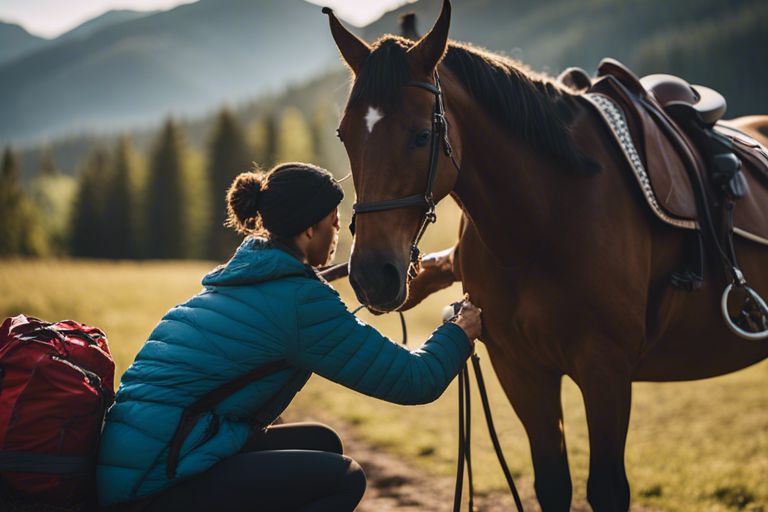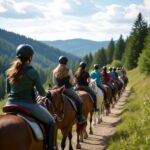You love the outdoors and have always wanted to experience the thrill of riding on horseback through stunning landscapes. Planning a horseback riding vacation can be an exciting and rewarding experience, but it requires careful consideration and preparation. In this guide, you will learn how to choose the right destination, pick the perfect riding tour, pack vital gear, and ensure a safe and enjoyable trip. Follow these steps to make sure your horseback riding vacation is a memorable adventure!

Understanding Your Horseback Riding Goals and Preferences
A horseback riding vacation is a great way to combine your love for travel and horses. Before you launch on planning your adventure, it’s important to understand your horseback riding goals and preferences to ensure you have an enjoyable experience.
Identifying Your Riding Level and Experience
Little experience or being a seasoned rider can impact the type of vacation that would best suit you. It’s important to be honest about your riding level to ensure your safety and enjoyment. Beginners may prefer a more leisurely ride with gentle horses, while experienced riders might seek out a challenging terrain with spirited mounts.
Determining Your Ideal Vacation Duration and Budget
Understanding your ideal vacation duration and budget will help narrow down your options. Consider how much time you can dedicate to your horseback riding vacation and how much you are willing to spend. Setting a budget will help you decide on the duration of your trip and the destination that fits within your financial means.
When determining your ideal vacation duration and budget, keep in mind that longer trips may allow you to explore more diverse terrains and offer a deeper horseback riding experience, but they can also be more costly. Decide on the balance that works best for you in terms of time and budget.
Considering Your Preferred Riding Style and Terrain
One of the key aspects of planning your horseback riding vacation is considering your preferred riding style and terrain. Identifying the type of riding experience you enjoy, whether it’s leisurely trail rides, fast-paced gallops, or even cross-country jumping, will help you choose a destination that caters to your preferences.
When considering your preferred riding style and terrain, think about the type of landscape you want to ride through. Some riders enjoy the challenge of mountain trails, while others prefer the tranquility of beach rides. Choosing the right terrain can make a significant difference in your overall horseback riding experience.

Choosing the Right Horseback Riding Destination
It’s imperative to choose the right destination for your horseback riding vacation to ensure you have an unforgettable experience. Whether you’re a beginner or an experienced rider, selecting the perfect location can make all the difference in your trip.
Researching Popular Horseback Riding Locations
On your quest to find the ideal horseback riding destination, researching popular locations is a great place to start. Look into well-known destinations such as Rocky Mountains, Grand Canyon, or Costa Rica, where you can enjoy breathtaking scenery and diverse trails catering to all riding levels.
Factors to Consider When Selecting a Destination
- Riding Experience: Ensure the destination offers trails suitable for your riding level.
- Accommodation: Check for comfortable lodging options near the riding area.
- Season: Consider the best time of year to visit based on weather and trail conditions.
After weighing these factors, you can narrow down your choices and select a destination that aligns with your preferences and riding abilities.
Any riding destination you choose should also consider factors such as the availability of guided tours, rental horses, or the option to bring your horse. Additionally, you may want to factor in the overall cost of the trip, including accommodations, meals, and any additional activities.
Tips for Evaluating Horseback Riding Operators and Guides
The reputation and expertise of the horseback riding operators and guides can significantly impact your experience. Before booking your trip, take the time to evaluate the qualifications, reviews, and safety record of the operators.
- Knowing the Guide: Ensure your guide is knowledgeable about the area, experienced in leading rides, and certified in first aid.
If you have any specific preferences or requirements, such as riding a certain breed of horse or exploring specific terrains, communicate these with the operators beforehand to ensure they can accommodate your needs.
Plus, always prioritize safety during your selection process. Look for operators that provide well-trained horses, proper safety gear, and adhere to safety protocols during the rides. Your well-being should be a top priority when choosing a horseback riding destination.
Planning Your Itinerary
Creating a Realistic Riding Schedule
Your horseback riding vacation should ideally include a well-thought-out itinerary that allows you to make the most of your time in the saddle. Any good itinerary should take into account your riding experience and physical fitness level, as well as the terrain and climate of the location you’ll be riding in. It’s important to set realistic daily riding goals based on these factors to ensure an enjoyable and safe experience.
Allowing for Downtime and Flexibility
To fully enjoy your horseback riding vacation, it’s imperative to incorporate downtime and flexibility into your itinerary. To avoid burnout and injury, make sure to schedule rest periods between rides and allow for unexpected changes in weather or trail conditions. Embracing flexibility will also give you the freedom to explore other activities or attractions in the area that may pique your interest.
Your downtime can be just as important as your time in the saddle. Use this time to relax, rejuvenate, and explore the surroundings at a leisurely pace. Whether it’s taking a scenic hike, enjoying a spa treatment, or simply unwinding with a good book, downtime can enhance your overall vacation experience.
Incorporating Non-Riding Activities and Excursions
In addition to horseback riding, consider incorporating non-riding activities and excursions into your itinerary to any make the most of your vacation. This could include visiting local museums, trying out new restaurants, or participating in adventure sports like zip-lining or rafting. These activities can add variety to your trip and provide you with a well-rounded experience of the destination.
Excursions can offer unique opportunities to immerse yourself in the local culture, discover hidden gems off the beaten path, and create lasting memories. Plan ahead and book excursions that align with your interests and schedule to maximize your enjoyment during your horseback riding vacation.
Packing and Preparing for Your Trip
After you have booked your horseback riding vacation, the next step is to pack and prepare for your trip. Proper planning and organization can make a significant difference in your overall experience. Here are some vital tips to help you pack efficiently and make sure you have everything you need for a successful adventure.
Essential Items to Bring Along
Preparing for a horseback riding vacation requires you to pack a few vital items to ensure your comfort and safety during the trip. Some of the must-have items include riding helmets, appropriate footwear such as riding boots or shoes with a heel, comfortable clothing that allows easy movement, sunscreen and insect repellent, and personal medications if needed. Additionally, you may want to bring water bottles, snacks, and a small first aid kit for minor emergencies.
Tips for Packing Light and Efficiently
Efficiently packing for your horseback riding vacation means bringing all the necessary items without overloading yourself with unnecessary baggage. To achieve this, consider rolling your clothes instead of folding them to save space, packing versatile clothing pieces that can be mixed and matched, and limiting the number of shoes you bring. Organize your items in separate bags or pouches to easily locate them when needed. Knowing how to pack smartly will help you enjoy the trip without feeling weighed down by your luggage.
- Rollling your clothes can save space and prevent wrinkles.
- Choose versatile clothing pieces that can be worn in different outfits.
- Limit the number of shoes to vitals such as riding boots and comfortable walking shoes.
Preparing Your Physical Condition for Horseback Riding
Tips to prepare your physical condition for horseback riding include engaging in regular exercise to strengthen your core and leg muscles for better balance and endurance. Stretching exercises can help improve flexibility and prevent stiffness after long hours of riding. Additionally, working on your posture will help you maintain a stable position on the saddle and reduce fatigue. A healthy diet and hydration are also vital for maintaining your energy levels during the trip.
Adhering to a regular exercise routine that focuses on core strength and flexibility will significantly enhance your riding experience. Paying attention to your posture and overall physical fitness will not only make you a better rider but also reduce the risk of injuries. It is important to take care of your body before launching on a horseback riding vacation to ensure a safe and enjoyable journey.

Booking and Preparing for Your Horseback Riding Activities
How to Book a Horseback Ride or Tour
The first step in planning your horseback riding vacation is booking your ride or tour. Unlike many other activities, horseback riding experiences often need to be scheduled in advance. You can either book directly through a ranch or tour company’s website or call to make a reservation. It’s important to consider the level of your riding experience and choose a ride that is suitable for you.
Understanding Liability Waivers and Safety Protocols
Before you commence on your horseback riding adventure, you will likely be required to sign a liability waiver. This document releases the stable or tour company from liability in case of accidents or injuries. It’s important to carefully read and understand the waiver before signing it. Additionally, each stable should have safety protocols in place to ensure a safe experience for both riders and horses.
Tour operators typically provide a safety briefing before the ride begins. They will go over basic riding instructions, safety guidelines, and how to communicate with your horse. It’s crucial to pay attention and follow these instructions to minimize the risk of accidents.
Preparing for Your Horseback Riding Adventure
Before heading out on your horseback riding adventure, there are a few things you can do to prepare. Make sure to wear appropriate attire, including comfortable pants and closed-toe shoes with a small heel. Consider bringing items like sunscreen, insect repellent, a hat, and water to stay comfortable during the ride.
- Understand the physical demands of horseback riding and be prepared for them.
- Always listen to your guide’s instructions and follow their lead throughout the ride. This will ensure a positive and safe experience for you and your horse.

Accommodations and Logistics
Finding Horse-Friendly Accommodations
If you are planning a horseback riding vacation, it is vital to find accommodations that are horse-friendly. Look for lodging that offers stables or paddocks for your horse to stay comfortably. Some accommodations may even have trails directly accessible from the property, making it convenient for you to start your riding adventures.
Arranging Transportation and Airport Transfers
Regarding arranging transportation and airport transfers for your horseback riding vacation, it is important to plan ahead. Consider renting a horse trailer or hiring a transportation service specialized in equine travel to ensure a safe and comfortable journey for your horse. Make sure to confirm any regulations or restrictions regarding transporting horses in different locations.
Understanding the logistics of transporting your horse and planning for adequate transportation are crucial aspects of your trip. Make sure to verify the availability of appropriate transportation options prior to your travel dates to avoid any last-minute hassles.
Planning for Meals and Dining Options
Finding accommodations that offer meal options or are located near restaurants can make your horseback riding vacation more convenient. Look for lodging that includes meal plans or is situated in areas with dining options that cater to equestrian travelers.
Conclusion
From above, planning a horseback riding vacation takes careful consideration and research to ensure a successful and enjoyable trip. By following the steps outlined in this guide, you can create a detailed itinerary, choose the right destination, book reputable accommodations and find experienced guides to make the most of your riding adventure. Remember to pack the necessary gear, plan for any emergencies, and most importantly, have fun exploring the beautiful landscapes on horseback.
Whether you are a beginner or an experienced rider, a horseback riding vacation offers a unique way to connect with nature and experience the thrill of riding in stunning environments. With proper planning and preparation, you can make memories that will last a lifetime and immerse yourself in the timeless beauty of the equestrian world. So saddle up, follow these tips, and get ready for an unforgettable journey on horseback.
Q: What should I consider when planning a horseback riding vacation?
A: When planning a horseback riding vacation, consider factors such as your riding experience level, desired location, budget, duration of the trip, and the type of riding experience you are looking for.
Q: How do I choose the right destination for a horseback riding vacation?
A: To choose the right destination for a horseback riding vacation, consider factors such as the terrain you want to ride on (beach, mountains, forests), the local culture and attractions, the availability of experienced guides, and the overall reputation of the destination for horseback riding.
Q: What equipment should I pack for a horseback riding vacation?
A: When packing for a horseback riding vacation, be sure to include necessarys such as riding boots or shoes with a heel, comfortable riding breeches or pants, a riding helmet, sunscreen, insect repellent, and appropriate clothing for the climate of the destination.
Q: How can I ensure my safety during a horseback riding vacation?
A: To ensure your safety during a horseback riding vacation, always follow the instructions of your guides, wear proper safety gear such as a helmet, stay alert and aware of your surroundings while riding, and communicate any concerns or physical limitations to the riding outfitter.
Q: What are some additional activities I can do during a horseback riding vacation?
A: In addition to horseback riding, you can often enjoy activities such as hiking, fishing, camping, wildlife watching, and cultural experiences during a horseback riding vacation. Be sure to inquire with the riding outfitter about other activities available in the area.










